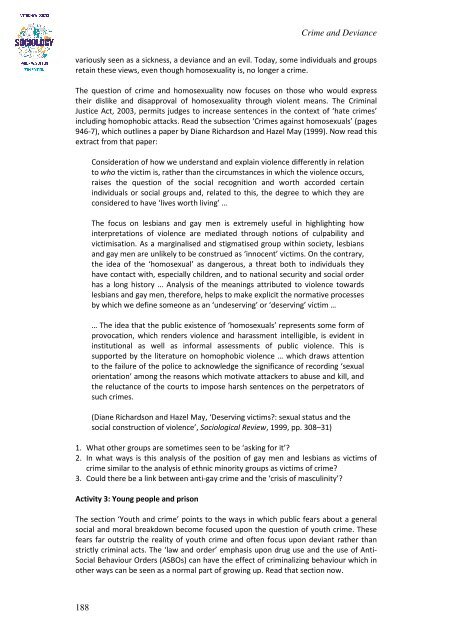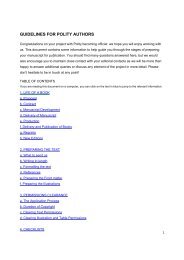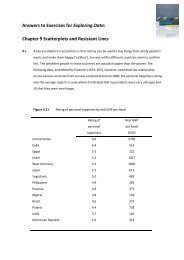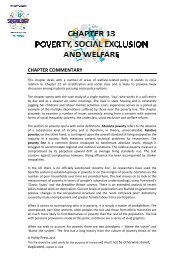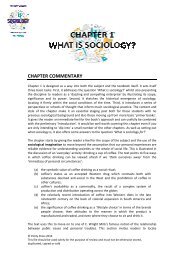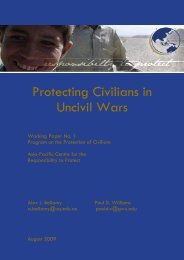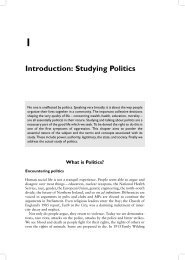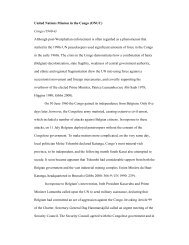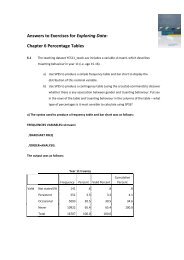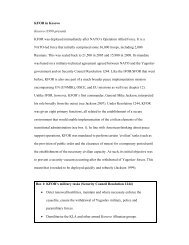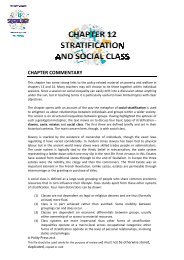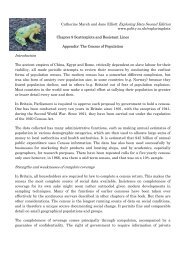Chapter 21 - Crime and Deviance - Polity
Chapter 21 - Crime and Deviance - Polity
Chapter 21 - Crime and Deviance - Polity
You also want an ePaper? Increase the reach of your titles
YUMPU automatically turns print PDFs into web optimized ePapers that Google loves.
<strong>Crime</strong> <strong>and</strong> <strong>Deviance</strong><br />
variously seen as a sickness, a deviance <strong>and</strong> an evil. Today, some individuals <strong>and</strong> groups<br />
retain these views, even though homosexuality is, no longer a crime.<br />
The question of crime <strong>and</strong> homosexuality now focuses on those who would express<br />
their dislike <strong>and</strong> disapproval of homosexuality through violent means. The Criminal<br />
Justice Act, 2003, permits judges to increase sentences in the context of ‘hate crimes’<br />
including homophobic attacks. Read the subsection ‘<strong>Crime</strong>s against homosexuals’ (pages<br />
946-7), which outlines a paper by Diane Richardson <strong>and</strong> Hazel May (1999). Now read this<br />
extract from that paper:<br />
Consideration of how we underst<strong>and</strong> <strong>and</strong> explain violence differently in relation<br />
to who the victim is, rather than the circumstances in which the violence occurs,<br />
raises the question of the social recognition <strong>and</strong> worth accorded certain<br />
individuals or social groups <strong>and</strong>, related to this, the degree to which they are<br />
considered to have ‘lives worth living’ …<br />
The focus on lesbians <strong>and</strong> gay men is extremely useful in highlighting how<br />
interpretations of violence are mediated through notions of culpability <strong>and</strong><br />
victimisation. As a marginalised <strong>and</strong> stigmatised group within society, lesbians<br />
<strong>and</strong> gay men are unlikely to be construed as ‘innocent’ victims. On the contrary,<br />
the idea of the ‘homosexual’ as dangerous, a threat both to individuals they<br />
have contact with, especially children, <strong>and</strong> to national security <strong>and</strong> social order<br />
has a long history … Analysis of the meanings attributed to violence towards<br />
lesbians <strong>and</strong> gay men, therefore, helps to make explicit the normative processes<br />
by which we define someone as an ‘undeserving’ or ‘deserving’ victim …<br />
… The idea that the public existence of ‘homosexuals’ represents some form of<br />
provocation, which renders violence <strong>and</strong> harassment intelligible, is evident in<br />
institutional as well as informal assessments of public violence. This is<br />
supported by the literature on homophobic violence … which draws attention<br />
to the failure of the police to acknowledge the significance of recording ‘sexual<br />
orientation’ among the reasons which motivate attackers to abuse <strong>and</strong> kill, <strong>and</strong><br />
the reluctance of the courts to impose harsh sentences on the perpetrators of<br />
such crimes.<br />
(Diane Richardson <strong>and</strong> Hazel May, ‘Deserving victims?: sexual status <strong>and</strong> the<br />
social construction of violence’, Sociological Review, 1999, pp. 308–31)<br />
1. What other groups are sometimes seen to be ‘asking for it’?<br />
2. In what ways is this analysis of the position of gay men <strong>and</strong> lesbians as victims of<br />
crime similar to the analysis of ethnic minority groups as victims of crime?<br />
3. Could there be a link between anti-gay crime <strong>and</strong> the ‘crisis of masculinity’?<br />
Activity 3: Young people <strong>and</strong> prison<br />
The section ‘Youth <strong>and</strong> crime’ points to the ways in which public fears about a general<br />
social <strong>and</strong> moral breakdown become focused upon the question of youth crime. These<br />
fears far outstrip the reality of youth crime <strong>and</strong> often focus upon deviant rather than<br />
strictly criminal acts. The ‘law <strong>and</strong> order’ emphasis upon drug use <strong>and</strong> the use of Anti-<br />
Social Behaviour Orders (ASBOs) can have the effect of criminalizing behaviour which in<br />
other ways can be seen as a normal part of growing up. Read that section now.<br />
188


